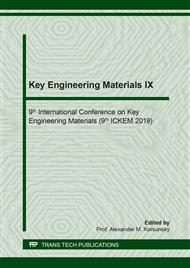[1]
C. Noutsopoulos, A. Andreadakis, N. Kouris, D. Charchousi, P. Mendrinou, A. Galani, I. Mantziaras, E. Koumaki, Greywater characterization and loadings - Physicochemical treatment to promote onsite reuse, J. Environ. Manage. 216 (2018) 337-346.
DOI: 10.1016/j.jenvman.2017.05.094
Google Scholar
[2]
S. Arden, X. Ma, Sci. Constructed wetlands for greywater recycle and reuse: A review, Total Environ, 630 (2018) 587-599.
DOI: 10.1016/j.scitotenv.2018.02.218
Google Scholar
[3]
M.W. Kee, J.W. Soo, S.M. Lam, J.C. Sin, A.R. Mohamed, Evaluation of photocatalytic fuel cell (PFC) for electricity production and simultaneous degradation of methyl green in synthetic and real greywater effluents, J. Environ. Manage. 228 (2018) 383-392.
DOI: 10.1016/j.jenvman.2018.09.038
Google Scholar
[4]
Y. Ye, H. Bruning, X.L. Li, D. Yntema, H.H.M. Rijnaarts, Significant enhancement of micropollutant photocatalytic degradation using a TiO2 nanotube array photoanode based photocatalytic fuel cell, Chem. Eng. J. 354 (2018) 553-562.
DOI: 10.1016/j.cej.2018.08.064
Google Scholar
[5]
S. Xie, K. Ouyang, Degradation of refractory organic compounds by photocatalytic fuel cell with solar responsive WO3/FTO photoanode and air-breathing cathode, J. Colloid Inter. Sci. 500 (2017) 220-227.
DOI: 10.1016/j.jcis.2017.04.002
Google Scholar
[6]
J.C. Sin, S.M. Lam, I. Satoshi, K.T. Lee, A.R. Mohamed, Sunlight photocatalytic activity enhancement and mechanism of novel europium-doped ZnO hierarchical micro/nanospheres for degradation of phenol, Appl. Catal. B: Environ. 148–149 (2014) 258-268.
DOI: 10.1016/j.apcatb.2013.11.001
Google Scholar
[7]
S.M. Lam, J.C. Sin, A.R. Mohamed, Cr2O3 nanoparticles anchored on ZnO nanorods as active heterostructure catalysts for phenol degradation, Sains Malays. 47 (2018) 253-259.
Google Scholar
[8]
S.M. Lam, J.A. Quek, J.C. Sin, Mechanistic investigation of visible light responsive Ag/ZnO micro/nanoflowers for enhanced photocatalytic performance and antibacterial activity, J. Photochem. Photobiol. A: Chem. 353 (2018) 171-185.
DOI: 10.1016/j.jphotochem.2017.11.021
Google Scholar
[9]
R. Saravanan, H. Shankar, T. Prakash, V. Narayanan, A. Stephen, ZnO/CdO composite nanorods for photocatalytic degradation of methylene blue under visible light, Mater. Chem. Phys. 125 (2011) 277-280.
DOI: 10.1016/j.matchemphys.2010.09.030
Google Scholar
[10]
Y. Bessekhouad, D. Robert, J.V. Weber, Bi2S3/TiO2 And CdS/TiO2 heterojunctions as an available configuration for photocatalytic degradation of organic pollutant, J. Photochem. Photobiol. A: Chem. 163 (2004) 569-580.
DOI: 10.1016/j.jphotochem.2004.02.006
Google Scholar
[11]
A. Zyoud, M. Dwikat, S. Al-Shakhshit, S. Ateeq, J. Shteiwi, A. Zubi, M.H.S. Helal, G. Campet, D.H. Park, H.S. Kwon, T.W. Kim, M. Kharoof, R. Shawahna, H.S. Hilal, Natural dye-sensitized ZnO nano-particles as photo-catalysts in complete degradation of E. coli bacteria and their organic content, J. Photochem. Photobiol. A Chem 328 (2016) 207–216.
DOI: 10.1016/j.jphotochem.2016.05.020
Google Scholar
[12]
S.M. Lam, J.C. Sin, A.Z. Abdullah, A.R. Mohamed, Investigation on visible-light photocatalytic degradation of 2,4-dichlorophenoxyacetic acid in the presence of MoO3/ZnO nanorod composites, J. Mol. Catal. A: Chem. 370 (2013) 123-131.
DOI: 10.1016/j.molcata.2013.01.005
Google Scholar
[13]
A. El Mragui, I.Daou, O. Zegaoui, Influence of the preparation method and ZnO/(ZnO + TiO2) weight ratio on the physicochemical and photocatalytic properties of ZnO-TiO2 nanomaterials, Accepted in Catal. Today (2018).
DOI: 10.1016/j.cattod.2018.01.016
Google Scholar
[14]
M. Jlassi, H. Chorfi, M. Saadoun, B. Bessaïs, ZnO ratio-induced photocatalytic behavior of TiO2–ZnO nanocomposite, Superlattices Microstruct. 62 (2013) 192-199.
DOI: 10.1016/j.spmi.2013.07.020
Google Scholar
[15]
J.Z. Ma, J.L. Liu, Y. Bao, Z.F. Zhu, H. Liu, Morphology-photocatalytic properties-growth mechanism for ZnO nanostructures via microwave-assisted hydrothermal synthesis, Cryst. Res. Technol. 48 (2013) 251-260.
DOI: 10.1002/crat.201300026
Google Scholar
[16]
M.J. Cao, F. Wang, J.F. Zhu, X. Zhang, Y. Qin, L. Wang, Shape-controlled synthesis of flower-like ZnO microstructures and their enhanced photocatalytic properties, Mater. Lett. 192 (2017) 1-4.
DOI: 10.1016/j.matlet.2017.01.051
Google Scholar
[17]
K.A. Wong, S.M. Lam, J.C. Sin, Wet chemically synthesized ZnO structures for photodegradation of pre-treated palm oil mill effluent and antibacterial activity, Accepted in Ceram. Intern. (2018).
DOI: 10.1016/j.ceramint.2018.10.078
Google Scholar


